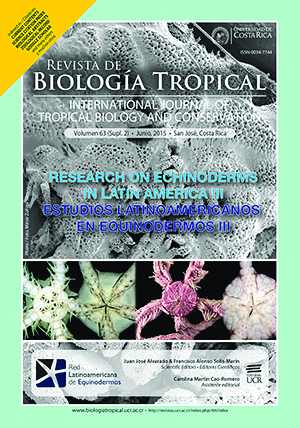Abstract
Echinometra lucunter is relatively abundant in the Venezuela coast, however no details are known about its diet. We compare the stomach contents and repletion index of E. lucunter with macroalgae available in their environment (June 2010-August) and the nutrient cycle at the Golfo de Cariaco. Seventy-one species of macroalgae were identified: Rhodophyta (45), Heterokontophyta (11) and Chlorophyta (15). The mean testa diameter was 41.04 ± 6.60 mm. The food preferences included filamentous, siphonal and calcaeous macroalgae; main food items were the filamentous macroalgae Sphacelaria sp. and Herposiphonia sp., and foliose Dictyota sp., including invertebrates such as sponges, bivalves and barnacle crustaceans. The repletion index was 0.8 - 6.0 % (2.6 ± 1.21 %), maximum values were associated to primary productivity cycle, i.e. December 2010 (6.0 ± 2.21 %), April (4.3 ± 0.34 %), June 2011 (4.0 ± 1.79 %). Food preferences could be associated to the upwelling season and productivity cycle.
References
Astudillo, D., Rosas J., Velásquez A., Cabrera T., & Maneiro, C. (2005). Crecimiento y supervivencia de larvas de Echinometra lucunter (Echinoidea: Echinometridae) alimentadas con las microalgas Chaetoceros gracilis e Isochrysis galbana. Revista de Biología Tropical, 53(Supl. 3), 377-344.
Barrios, J. & Reyes, J. (2008). Hábitos alimenticios de Tripneustes ventricosus (Lamarck, 1816) (Echinodermata, Echinoidea) en Isla Tortuga, Venezuela. Foro Iberoamericano de Recursos Marinos y Acuicultura, 2, 583-589.
Boudouresque, C., & Verlaque, M. (2007). Ecology of Paracentrotus lividus. In J. M. Lawrence (Ed.), Edible Sea Urchins: Biology and Ecology (pp. 243-285). Amsterdam: Elsevier.
Chapman, V. (1961). The marine algae of Jamaica. Part I. Myxophyceae and Chorophyceae. Bulletin of the Institute of Jamaica, Science Series, 12, 1-159.
Chapman, V. (1963). The marine algae of Jamaica. Part II. Phaeophyceae and Rhodophyceae. Bulletin of the Institute of Jamaica, Science Series, 10, 1-201.
Cobb, J., & Lawrence, J. (2005). Diets and coexistence of the sea urchins Lytechinus variegatus and Arbacia punctulata (Echinodermata) along the central Florida gulf coast. Marine Ecology Progress Series, 295, 171–182.
Cruz-Motta, J. (2007). Análisis espacial de las comunidades tropicales intermareales asociadas a los litorales rocosos de Venezuela. Ciencias Marinas, 33, 133-148.
Erickson, A., Paul, V., Van Alstyne, K., & Kwiatkowski, L. (2006). Palatability of Macroalgae that Use Different Types of Chemical Defenses. Journal Chemical Ecology, 32, 1883-1895.
Espinoza, R., Reyes, J., Himmelman, J., & Lodeiros, C. (2008). Actividad reproductiva de los erizos Lytechinus variegatus y Echinometra lucunter (Echinodermata: Echinoidea) en relación con factores ambientales en el Golfo de Cariaco, Venezuela. Revista de Biología Tropical, 56(Suppl. 3), 341-350.
Ferreira, C., Santos de Oliveira, A., & Crespo, R. (2008). Feeding preference of the sea urchin Lytechinus variegatus (Lamarck, 1816) on seaweeds. Brazilian Journal of Oceanography, 56, 239-247.
Hendler, G., Miller, J., Pawson, D., & Porter, K. (1995). Sea Stars, Sea Urchins, and Allies. Echinoderms of Florida and the Caribbean. Washington: Smithsonian Institution Press.
Joly, A. (1967). Géneros de algas marinhas da costa Atlántica latino-americana. Brasil: Edit. Universidad de São Paulo.
Lawrence, J., Lawrence, A., & Watts, S. (2007). Feeding, digestion, and digestibility. In J. M. Lawrence (Ed.), Edible Sea Urchins: Biology and Ecology (pp. 135-158). Amsterdam: Elsevier.
Lemus, A. (1979). Las algas marinas del Golfo de Paria, Venezuela. I. Chlorophyta y Phaeophyta. Boletin del Instituto de Oceanografía de la Universidad de Oriente, 18, 17-36.
Lemus, A. (1984). Las algas marinas del Golfo de Paria, Venezuela. II. Rhodophyta. Boletin del Instituto de Oceanografía de la Universidad de Oriente, 23, 55-112.
Lodeiros, C., & Himmelman, J. (2000). Identification of factors affecting growth and survival of the tropical scallop Euvola (Pecten) ziczac in suspended culture in the Golfo de Cariaco, Venezuela. Aquaculture, 182, 91-114.
Lodeiros, N., & García, N. (2004). The use of sea urchins to control fouling during suspended culture of bivalves. Aquaculture, 231, 293-298.
Martínez, A. (1986). Equinodermos de la Isla de Aves, Venezuela. Boletin del Instituto de Oceanografía de la Universidad de Oriente, 25, 195-213.
McClanahan, T., & N. Muthiga. (2007). Ecology of Echinometra. In J. M. Lawrence (Ed.), Edible Sea Urchins: Biology and Ecology. Amsterdam: Elsevier.
Murillo-Navarro, R., & D. Jiménez-Guirado. (2012). Relationships between algal food and gut and gonad conditions in the Mediterranean sea urchin Paracentrotus lividus (Lam.). Mediterranean Marine Science, 13, 227-238.
Penchaszadeh, P., León, C., Álvarez, H., Bone, D., Castellano, P., Castillo, M., … Villamizar, A. (2000). Venezuela. In C. R. Sheppard (Ed.), Seas at the Millenium; an Environmental Evaluation, Vol. I. (pp. 620-662). Pergamon: Oxford.
Pirela-Ochoa, E., Troccoli. L., & Hernández,-Ávila, I. (2008). Hidrografía y cambios en la comunidad del microfitoplancton de la Bahía de Charagato, Isla de Cubagua, Venezuela. Boletin del Instituto de Oceanografía de la Universidad de Oriente, 47, 3-16.
Schoppe, S., & Werding, B. (1996). The boreholes of the sea urchin genus Echinometra (Echinodermata: Echinoidea: Echinometridae) as microhabitat in tropical South America. P. S. Z. N. I. Marine Ecology, 17, 181-186.
Steneck, R., & Dethier, M. (1994). A functional group approach to the structure of algal dominated communities. Oikos, 69, 476-498.
Taylor, W. (1960). Marine algae of the eastern tropical and subtropical coast of the Americas. Michigan: Lord Baltimore Press, INC., Universidad de Michigan.
Wynne, M. (2011). A check-list of benthic marine algae of the tropical and subtropical western Atlantic: third revision. Nova Hedwigia, 140, 1-166.
Zar, J. (2010). Biostatistical Analysis. USA: Pearson Education.
Zoppi, E. (1967). Contribución al estudio de los equinodermos de Venezuela. Acta Biológica de Venezuela, 5, 267-283.
##plugins.facebook.comentarios##

This work is licensed under a Creative Commons Attribution 4.0 International License.
Copyright (c) 2015 Revista de Biología Tropical






